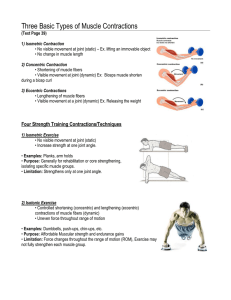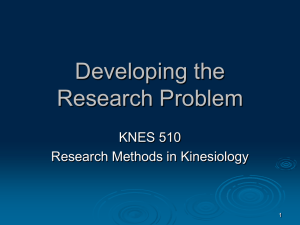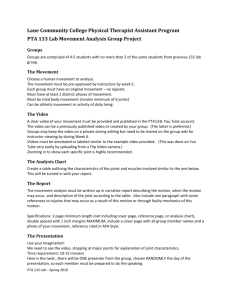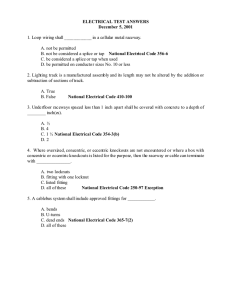Triphasic Training Methods: Advanced Sports Performance
advertisement
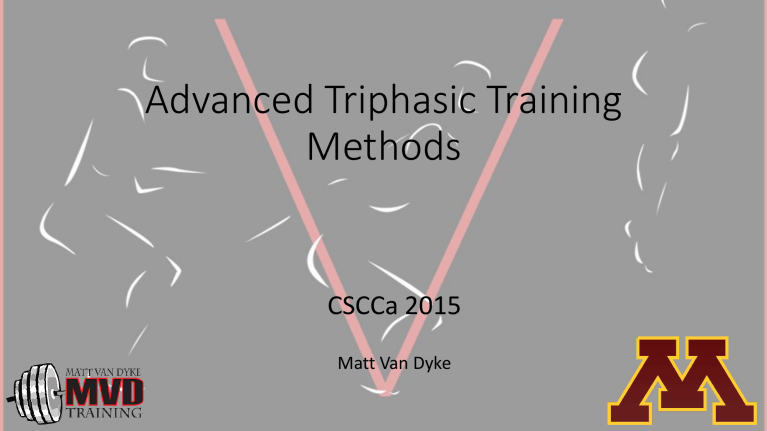
Advanced Triphasic Training Methods CSCCa 2015 Matt Van Dyke Goals of Triphasic Training • Transfer of training is ultimate goal • Every movement or action is a learned skill • Must “teach” athletes proper skills required • Stress the body optimally • Must be completed with a purpose • Quality of work • Specific to high-intensity requirements • Prevent body from being pulled in too many directions • Number of qualities trained • Per day and per block • Triathlete example 3 Components of Triphasic Training 1. Block Training Model • Based on residual effects • Allows multiple peaks per year 2. Modified Undulated Training • Based on day • Keeps organism from being “pulled” in too many directions 3. Triphasic Muscle Action • 3 muscle actions of every dynamic movement • Eccentric • Isometric • Concentric Block Training Model – 3 Phases • Accumulation • Aimed at developing basic motor qualities • Aerobic system • Max strength • Longest Phase • Transmutation • Aimed at developing specific motor abilities to competition • Strength-specific endurance • Power • Adaptation peaks after 3 week block • Realization • Develops pre-competition readiness levels (peaking) • Max Speed and RFD • Completed as close to competition as possible Block Training Model Block Training Model • Multiple peaks in a smaller training period • All qualities peaked simultaneously • Maximized performance Modified Undulated Training • Training percent and volume based on day • Ensures organism is “pulled” or adapts in the desired direction • Timed sets • Train specifically for competitive event • Right at competition time • Just above • Just below Modified Undulated Training Supramaximal Modified Undulated Training Triphasic Muscle Action • Every movement contains 3 phases • Eccentric • Muscle lengthening • Isometric • No length change • Most commonly missed action • Concentric • Muscle shortening • Ultimate goal is improving efficiency and power of SSC Eccentric Training Phase • Vital for deceleration • Stresses muscle fibers and tendons with slow movements • Cannot produce what you cannot absorb • Concentric portion of “V” never steeper than eccentric portion • Tissue remodeling • Myosin “forcefully ripped” from actin binding site • Microscopic damage • Fewer attachment sites used so greater stress on each myosin head • Body adapts and rebuilds stronger attachment site Eccentric Training Phase • Forces correct technique • Focus on exploding concentrically at end of set • Supramaximal training • • • • Force-velocity curve of muscle Eccentric is strongest muscle phase Only with advanced athletes Have a spotter on both sides of the bar Hands Assisted-Safety Bar Split Squat • Unilateral movement for advanced athletes • Most specific • Safety bar frees hands • Maximizes stress on body and nervous system • Core training • Transferring force through the entire kinetic chain • Ensure legs are around 90-90 • Back leg extension means hips pulled out of alignment • Belly breathing throughout rep is encouraged Eccentric Example Exercises • Slow and controlled motion for duration of set • Hands Assisted-Safety Bar Split Squat • Partner Pull Up • Manual Bench Adduction • Manual Hip Flex Prone Isometric Training Phase • Brief transition from eccentric to concentric • Commonly missed phase • Not easily seen in “V” of muscle actions • Eccentric improved absorption, isometric must now withstand increased forces • \_/ vs. V • If left untrained, athlete will “bleed” power Isometric Training Phase • Continued tissue remodeling • Strengthen attachment sites • Fewer attachment sites used so still greater stress than concentric • Improve ability to “anchor on” • Increases stretching of tendons • Maximizes “free-energy” of SSC • Train similar to joint angle in competition • Focus on exploding concentrically at end of set • Supramaximal training • Isometric still stronger than concentric • Only with advanced athletes • Use spotters Isometric Example Exercises • Pull down with high-velocity, yet under control, and immediately halt movement • Hands Assisted-Safety Bar Split Squat • Partner Pull Up • Manual Bench Adduction • Manual Hip Flex Prone Concentric Muscle Action • “Typical” strength training • Combines all 3 phases of dynamic movement • Timed sets competition specific • Maximize work completed • Supramaximal training not possible 4 Blocks of Triphasic Training • GPP (General Physical Preparedness) • Basic preparation • Triphasic Muscle Action Training • Above 80% • Supramaximal • High-Velocity, High-Load Phase • 55-80% • High-Velocity, Low-Load Phase • Below 55% GPP Training • Maximize oxygen intake by body and kinetics to muscles • Optimize clearance of metabolites produced at high-intensities • Aerobic system is vital for repeat sprint ability • Improve Cr-P ATP re-synthesis abilities • Removal of metabolic waste • Glycolysis • 10-120 seconds • Prepares athletes for high-intensity repeat bouts • Alactic Training • 0-10 seconds • Training not “sport specific” GPP Blocks 1. Aerobic Block • HIIT Circuit Style • Contralateral 2. Glycolysis Block • 30 sec. on 10 off • SA/SL to prevent systemic metabolite accumulation 3. Alactic/Myelination Block • 10 sec. on 30 off • Max Iso Effects of GPP Training on Repeat Sprints Pre-GPP Post-GPP Block Training Model – 3 Phases • Accumulation • Aimed at developing basic motor qualities • Aerobic system • Max strength • Transmutation • Aimed at developing specific motor abilities to competition • Strength-specific endurance • Power • Realization • Develops pre-competition readiness levels (peaking) • Max Speed Triphasic Muscle Action Block • Most well known for this block • Every movement contains 3 phases • Eccentric • Isometric • Concentric • Only block that utilizes these muscle actions in sequencing • Training still not “sport specific” • Preparing for optimal transfer of training French Contrast Method • Potentiation effect of Above 80/Supramaximal Training • Consists of 3 Jumps • Body weight – Hurdle Hops • Slightly weighted – Weighted Squat Jump with Pause • Accelerated – Accelerated Band Jump • Based on competition like timed sets • Just at competition speed – body weight • Just below – slightly weighted • Just above – accelerated French Contrast Example • Lower Ecc. and Iso. Phases • Upper Ecc. and Iso. Phases • Lower Conc. Power and Peak • Upper Conc. Power and Peak Block Training Model – 3 Phases • Accumulation • Aimed at developing basic motor qualities • Aerobic system • Max strength • Transmutation • Aimed at developing specific motor abilities to competition • Strength-specific endurance • Power • Realization • Develops pre-competition readiness levels (peaking) • Max Speed High-Velocity, High-Load Power Block • Designed to maximize power • Power=Force x Velocity • Exercises progress “down the force curve” • Produce the most force possible with the highest velocity • Entire block occurs between 55 and 80% • Load still heavy, but athlete is able to increase velocity Force Velocity Curve - Power Biometric Drop-Off Training • Designed to maximize training on an individual basis • Ensures athlete is stimulated appropriately • Never overtrained or undertrained • Repeat Sprint Ability • Change drop-off percentage based on how often you desire to train specific quality • 10% drop requires 3-5 days rest typically • 3% drop can be trained nearly every day • Maximal speed effort after warm up Block Training Model – 3 Phases • Accumulation • Aimed at developing basic motor qualities • Aerobic system • Max strength • Transmutation • Aimed at developing specific motor abilities to competition • Strength-specific endurance • Power • Realization • Develops pre-competition readiness levels (peaking) • Max Speed High-Velocity, Low-Load Peaking Block • Training at velocities most closely related to athletic event • Maximizes transfer of training • Allows realization of strength improvements from earlier blocks • Continues using exercises that have been used through all cycles • Hands-assisted safety bar split squat to Lunge OC Hops • Targets explosive type II fibers Force Velocity Curve – Maximal Speed RFD in Athletics • Success predicted by which athlete can produce greatest force in time allotted • Not enough time to produce max force • Most athletic movements executed in under 250 ms • 300 to 400 ms to reach peak force • Max force plays role, but not most important • Dependent on multiple factors • Neural & Mechanical • Recruitment • Rate coding • Skill learning • Antagonist co-activation Force Curve Changes Due to Training RFD Changes Due to Training AFSM and Oscillatory (OC) Training • Elite athletes not only contract muscles faster, but also relax faster • Co-activation of antagonist reduced • Increased RFD • AFSM • Full range of motion movement • Push away and pull implement • OC • Small range of motion • 3-4 inch • Completed in advantageous or disadvantageous position • Adv. for max speed • Dis. for acceleration AFSM and OC Examples • Lunge OC Hops • GH Hyper OC • DB OC Row • Speed Band Adduction • Speed Cycle Jump Lunge – Can make accelerated Block Training Model – 3 Phases • Accumulation • Aimed at developing basic motor qualities • Aerobic system • Max strength • Transmutation • Aimed at developing specific motor abilities to competition • Strength-specific endurance • Power • Realization • Develops pre-competition readiness levels (peaking) • Max Speed • All Qualities Now Peaked Simultaneously! Triphasic Program Phases • Not many coaches have 23 weeks to dedicate solely to training Triphasic Training In-Season Model • Once quality is originally trained, it is easily adapted again • Especially if residual effects are factored • Allows muscle actions to be re-trained with less fatigue • Stay in 55-80% block generally • Use block periodization to re-peak multiple times per season Annual Football Triphasic Model Max Speed Training and Conditioning • Follow modified undulated block • Utilize same timed sets as used in weight room for each day • Implement running day within training • Acceleration day • Hurdle hops for distance (angle used in acceleration) • Sled pulls can be used within French contrast as well • Always consider volume • Train max speed while freshest • Give time for complete recovery • Must run fast to become faster • Condition post-training if desired Secrets to Success • What am I trying to accomplish • Does it do what I want? • Understanding adaptation principles • The method of Completing Exercise • Natural • Kinematic Sequencing • Transferring force through body • Skill is everything – everything is a learned skill • Quality vs. Quantity • Always low reps • Times based on competition event Bringing it All Together • Maximizing transfer of training is the ultimate key to successful training • Choose exercises that have high levels of transfer of training • “Pull” Organism in one direction • Quality of work is crucial to success in team sports • Repeat sprint ability – always need max effort available • Triphasic Training can be applied to any program currently run • Muscle actions • Block training method Future of Triphasic Training • Advanced Principles of Triphasic Training • Supramaximal and other new methods explained in depth • By: Cal Dietz & Jonathan Janz • Skill Learning and The Advanced Peaking Model in Competition • Advancements in peaking and how to maximize transfer of training • Progressions for each exercise through training blocks • By: Cal Dietz & myself • GPP • P.C.S.P model • By: Cal Dietz & Ben Peterson Special Thanks • Cal Dietz • Ben Peterson • St. Cloud State University HPL • Gary Boros • Iowa State Football Staff Questions? Lift Examples Eccentric Lower Training Block Example Eccentric Upper Training Block Example Isometric Lower Training Block Example Isometric Upper Training Block Example Concentric Lower Training Block Example Concentric Upper Training Block Example Power Lower Example Power Upper Example Peaking Lower Example Peaking Upper Example

